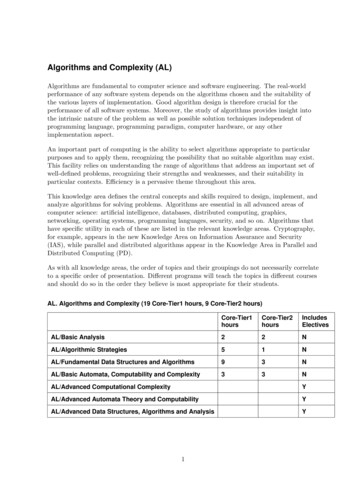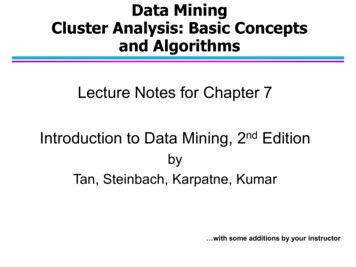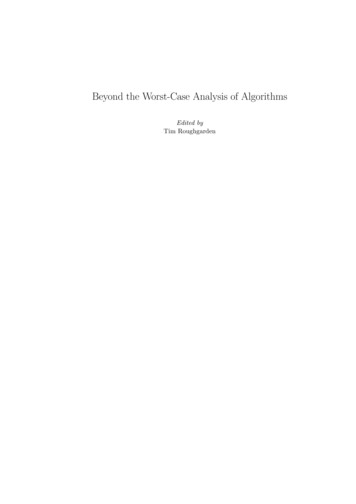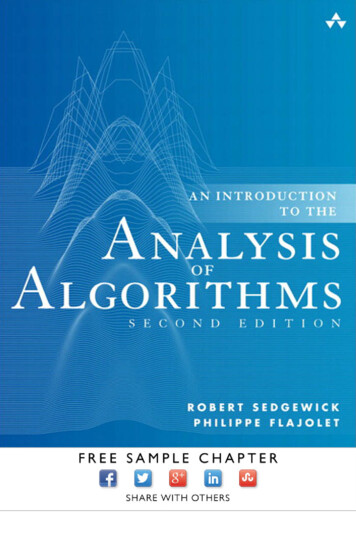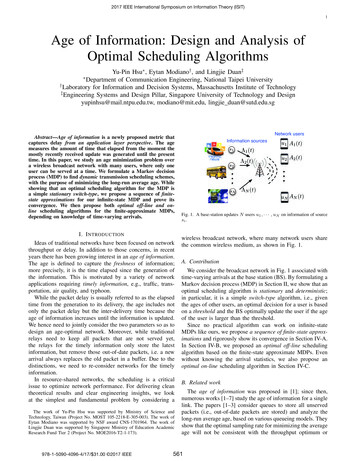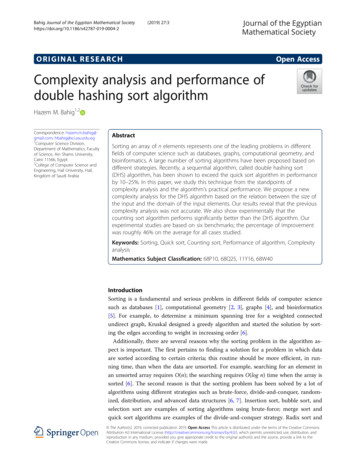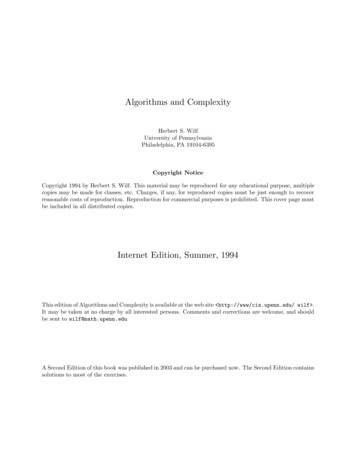
Transcription
Complexity Analysisof AlgorithmsJordi CortadellaDepartment of Computer Science
Estimating runtimeWhat is the runtime of g(n)?void g(int n) {for (int i 0; i n; i) f();}void g(int n) {for (int i 0; i n; i)for (int j 0; j n; j) f();}Introduction to Programming Dept. CS, UPC2
Estimating runtimeWhat is the runtime of g(n)?void g(int n) {for (int i 0; i n; i)for (int j 0; j i; j) f();}Introduction to Programming Dept. CS, UPC3
Complexity analysis A technique to characterize the execution time ofan algorithm independently from the machine, thelanguage and the compiler. Useful for:– evaluating the variations of execution time with regardto the input data– comparing algorithms We are typically interested in the execution timeof large instances of a problem, e.g., when 𝑛 ,(asymptotic complexity).Introduction to Programming Dept. CS, UPC4
Big O A method to characterize the execution time ofan algorithm:––––––Adding two square matrices is O(n2)Searching in a dictionary is O(log n)Sorting a vector is O(n log n)Solving Towers of Hanoi is O(2n)Multiplying two square matrices is O(n3) The O notation only uses the dominating termsof the execution time. Constants are disregarded.Introduction to Programming Dept. CS, UPC5
Big O: formal definition Let T(n) be the execution time of an algorithm whenthe size of input data is n. T(n) is O(f(n)) if there are positive constants c and n0such that T(n) c f(n) when n n0.c f(n)T(n)nn0Introduction to Programming Dept. CS, UPC6
Big O: example Let T(n) 3n2 100n 5, then T(n) O(n2) Proof:– Let c 4 and n0 100.05– For n 100.05, we have that 4n2 3n2 100n 5 T(n) is also O(n3), O(n4), etc.Typically, the smallest complexity is used.Introduction to Programming Dept. CS, UPC7
Big O: examplesIntroduction to Programming Dept. CS, UPC8
Complexity rankingIntroduction to Programming Dept. CS, UPC9
Complexity analysis: examplesLet us assume that f() has complexity O(1)for (int i 0; i n; i) f();for (int i 0; i n; i)for (int j 0; j n; j) f();for (int i 0; i n; i)for (int j 0; j i; j) f();for (int i 0; i n; i)for (int j 0; j n; j)for (int k 0; k n; k) f();for (int i 0; i m; i)for (int j 0; j n; j)for (int k 0; k p; k) f();Introduction to Programming Dept. CS, UPC10
Complexity analysis: examplesif (condition) {O(𝒏𝟐 )O(𝒏)} else {O(𝒏𝟐 )O(𝒏)}Introduction to Programming Dept. CS, UPC11
Complexity analysis: recursionvoid f(int n) {if (n 0) {DoSomething(n); // O(n)f(n/2);}}Introduction to Programming Dept. CS, UPC12
Complexity analysis: recursionvoid f(int n) {if (n 0) {DoSomething(n); // O(n)f(n/2); f(n/2);}}nn/2n/4 n/2n/4 n/4 n/4 1 1 1 1 1 1 1 1 1 1 1 1 1 1 1 1Introduction to Programming Dept. CS, UPC13
Complexity analysis: recursionvoid f(int n) {if (n 0) {DoSomething(n); // O(n)f(n-1);}}Introduction to Programming Dept. CS, UPC14
Complexity analysis: recursionvoid f(int n) {if (n 0) {DoSomething(); // O(1)f(n-1); f(n-1);}}Introduction to Programming Dept. CS, UPC15
Asymptotic complexity (small values)Introduction to Programming Dept. CS, UPC16
Asymptotic complexity (larger values)Introduction to Programming Dept. CS, UPC17
Execution time: exampleLet us consider that every operation can beexecuted in 1 ns (10-9 s).Introduction to Programming Dept. CS, UPC18
How about “big data”?Source: Jon Kleinberg and Éva Tardos, Algorithm Design, Addison Wesley 2006.This is often the practical limit for big dataAlgorithm Analysis Dept. CS, UPC19
Summary Complexity analysis is a technique to analyze and comparealgorithms (not programs). It helps to have preliminary back-of-the-envelopeestimations of runtime (milliseconds, seconds, minutes,days, years?). Worst-case analysis is sometimes overly pessimistic.Average case is also interesting (not covered in this course). In many application domains (e.g., big data) quadraticcomplexity, 𝑂 𝑛2 , is not acceptable. Recommendation: avoid last-minute surprises by doingcomplexity analysis before writing code.Introduction to Programming Dept. CS, UPC20
-Searching in a dictionary is O(log n) -Sorting a vector is O(n log n) . Source: Jon Kleinberg and Éva Tardos, Algorithm Design, Addison Wesley 2006. This is often the practical limit for big data. Summary Complexity analysis is a technique to analyze and compare algorithms (not programs).



